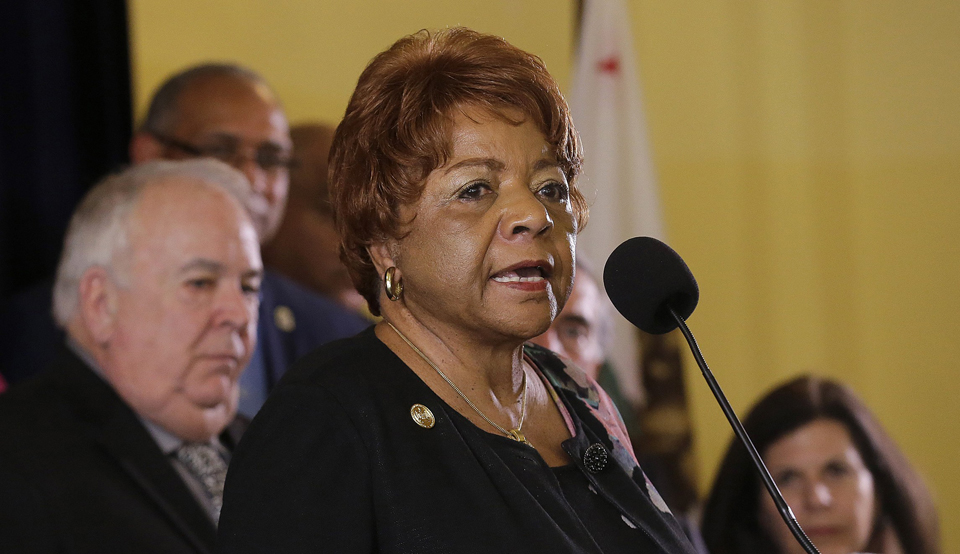
WASHINGTON—The president of the California NAACP is slamming the nation’s burgeoning charter school movement as bad for teachers, bad for kids and bad for accountability to parents. And it especially hurts kids in inner-city schools, Alice Huffman says.
Huffman headed a special NAACP commission on the charters after her state chapter raised the issue at the last convention of the nation’s oldest civil rights group, she told a May 9 symposium on charters and their impact on public schools.
It found, in so many words, that charters were a mess: Most did not fulfill their promises, they keep their budgets and spending secret, they discriminate against the disabled, and they yank due process protections from disciplined kids and from their teachers, too.
The American Federation of Teachers, which has been skeptical of charters — and which is also trying to organize many of them – sponsored the symposium, along with the union’s Albert Shanker Institute.
“I don’t have the data” the other panelists presented, Huffman said. “I want to talk about the kids.”
“Believers in privatization” of schools, including for-profit charter school operators, “want to get the pot of dollars” states make available to public schools, she said. “And the one group they hated more than African-Americans was unions.”
She also set charters as one of several public school “remedies” that hurt minority-group kids. Charters, Huffman said, were preceded by vouchers and tuition tax credits funneling public dollars to parents of private school kids.
In the South, after the Supreme Court’s 1954 school desegregation ruling, the response was to close the public schools rather than integrate. But charters take advantage of parents’ desires for the best education for their children, Huffman noted – a desire mostly left unfulfilled, the NAACP report last year found.
Other panelists at the May 9 session also criticized charters, for different reasons. Most pointed was David Arsen, a Michigan State University education policy professor. He faulted the state’s politicians for bending to a strenuous lobbying campaign by GOP big giver Elizabeth “Betsy” DeVos against public schools in general and for charters.
Overcoming opposition from the state’s teachers’ unions and even the Chamber of Commerce, she won. Michigan’s charters, Arsen said, have virtually no accountability for their results, which have sunk the state to the bottom of national rankings in achievement, per-pupil spending and other measures.
DeVos, a vitriolic foe of public schools in general and unions in particular, is now carrying on the same crusade as GOP President Donald Trump’s Education Secretary – over opposition from the AFL-CIO, AFT, the National Education Association, the School Administrators (AFSA) and other unions.
Cities nationwide often use charters to evade union contracts, financial accountability to parents and, sometimes, teacher standards. The for-profit charter operators promise better student performance, but often – including in Detroit and Milwaukee – haven’t delivered.
That’s what prompted California’s complaint and the NAACP panel Huffman headed. It visited charter systems in New Orleans, New York, Detroit, Milwaukee, Cleveland and elsewhere.
Ironically, Huffman noted, Shanker, the union’s dominant president in the 1960s, first came up with the idea of charters. But he envisioned them as cooperating with public schools and demonstrating best practices public schools could then adopt. Instead, she said, charter operators have put profits before students in many cases.
Charter schools have proliferated in many major cities. Due to the unique circumstances following Hurricane Katrina, Louisiana’s Democratic governor, under pressure from the GOP George W. Bush administration, dismantled the New Orleans Parish School District – and AFT Local 1 with it – and converted most of its schools to charters. As a result, charters educate 71 percent of New Orleans students, the top ratio in the U.S.
Other cities with high charter school student shares include Detroit (51 percent), Washington, D.C. (43 percent), Flint, Mich. (36 percent), Kansas City (36 percent), Gary, Ind. (35 percent), Cleveland (29 percent), Philadelphia, Dayton, Ohio, and Indianapolis, Ind. (28 percent). All those cities, plus New Orleans, have majority-minority student populations.
“I don’t believe two systems” – public and charter schools – “are compatible,” said Huffman, who worked for AFT’s California affiliate for 13 years. “Charters don’t have to have certificated teachers who must learn how to teach, they make the public schools ‘a place of last resort,’ and they’re not regulated.”
“What would make the system work is to regulate them” and subject them to the same standards and accountability, through elected officials – from school boards to state legislatures – public schools face, she said. “Make them public schools, not quasi-public schools.”
“Instead, we built an environment where the privatizers come in and say ‘we can do it better’” than public schools. “We should have invested in” what the Supreme Court insisted on in its famous 1954 Brown vs Board of Education desegregation decision: “Equality.”
One way to get that, Huffman said, is to create incentives – she did not say how – to “get the best teachers to teach in the schools that need them the most,” especially in the inner cities. The NAACP report, published last year, fills in some of the gaps.
It recommends school funding change on the federal, state and local levels, to channel more money to districts that need it the most, incentive pay for the best teachers to come to those schools, and “wraparound services” at the schools – everything from early childhood education to food to extended learning time and social supports. The wraparounds are a prime AFT cause.










